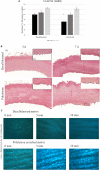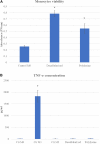Polylysine Enriched Matrices: A Promising Approach for Vascular Grafts
- PMID: 32318560
- PMCID: PMC7147808
- DOI: 10.3389/fbioe.2020.00281
Polylysine Enriched Matrices: A Promising Approach for Vascular Grafts
Abstract
Cardiovascular diseases represent the leading cause of death in developed countries. Modern surgical methods show poor efficiency in the substitution of small-diameter arteries (<6 mm). Due to the difference in mechanical properties between the native artery and the substitute, the behavior of the vessel wall is a major cause of inefficient substitutions. The use of decellularized scaffolds has shown optimal prospects in different applications for regenerative medicine. The purpose of this work was to obtain polylysine-enriched vascular substitutes, derived from decellularized porcine femoral and carotid arteries. Polylysine acts as a matrix cross-linker, increasing the mechanical resistance of the scaffold with respect to decellularized vessels, without altering the native biocompatibility and hemocompatibility properties. The biological characterization showed an excellent biocompatibility, while mechanical tests displayed that the Young's modulus of the polylysine-enriched matrix was comparable to native vessel. Burst pressure test demonstrated strengthening of the polylysine-enriched matrix, which can resist to higher pressures with respect to native vessel. Mechanical analyses also show that polylysine-enriched vessels presented minimal degradation compared to native. Concerning hemocompatibility, the performed analyses show that polylysine-enriched matrices increase coagulation time, with respect to commercial Dacron vascular substitutes. Based on these findings, polylysine-enriched decellularized vessels resulted in a promising approach for vascular substitution.
Keywords: decellularized vessels; matrix degradation; polylysine; surface grafting; vascular substitutes.
Copyright © 2020 Fusaro, Calvo Catoira, Ramella, Sacco Botto, Talmon, Fresu, Hidalgo-Bastida and Boccafoschi.
Figures







Similar articles
-
Decellularized Native and Engineered Arterial Scaffolds for Transplantation.Cell Transplant. 2003 Sep;12(6):659-666. doi: 10.3727/000000003108747136. Cell Transplant. 2003. PMID: 28866947
-
Biocompatibility and hemocompatibility of efficiently decellularized whole porcine kidney for tissue engineering.J Biomed Mater Res A. 2018 Jul;106(7):2034-2047. doi: 10.1002/jbm.a.36407. Epub 2018 Apr 17. J Biomed Mater Res A. 2018. PMID: 29569325
-
Development and evaluation of a novel decellularized vascular xenograft.Med Eng Phys. 2002 Apr;24(3):173-83. doi: 10.1016/s1350-4533(02)00010-3. Med Eng Phys. 2002. PMID: 12062176
-
Decellularized biological matrices: an interesting approach for cardiovascular tissue repair and regeneration.J Tissue Eng Regen Med. 2017 May;11(5):1648-1657. doi: 10.1002/term.2103. Epub 2015 Oct 29. J Tissue Eng Regen Med. 2017. PMID: 26511323 Review.
-
Application of decellularized vascular matrix in small-diameter vascular grafts.Front Bioeng Biotechnol. 2023 Jan 6;10:1081233. doi: 10.3389/fbioe.2022.1081233. eCollection 2022. Front Bioeng Biotechnol. 2023. PMID: 36686240 Free PMC article. Review.
Cited by
-
Metabolomic Analysis of Biosynthesis Mechanism of ε-Polylysine Produced by Streptomyces diastatochromogenes.Front Bioeng Biotechnol. 2021 Jul 30;9:698022. doi: 10.3389/fbioe.2021.698022. eCollection 2021. Front Bioeng Biotechnol. 2021. PMID: 34395404 Free PMC article.
-
Biomaterials for Regenerative Medicine in Italy: Brief State of the Art of the Principal Research Centers.Int J Mol Sci. 2022 Jul 26;23(15):8245. doi: 10.3390/ijms23158245. Int J Mol Sci. 2022. PMID: 35897825 Free PMC article. Review.
References
-
- Amuzescu B., Istrate B., Mubagwa K. (2016). “Impact of cellular mechanisms of ischemia on CABG failure,” in Coronary Graft Failure, eds þintoiu I., Underwood M., Cook S., Kitabata H., Abbas A., (Cham: Springer; ), 10.1007/978-3-319-26515-5_31 - DOI
-
- Athanasiou T., Saso S., Rao C., Vecht J., Grapsa J., Dunning J., et al. (2011). Radial artery versus saphenous vein conduits for coronary artery bypass surgery: forty years of competition - which conduit offers better patency? A systematic review and meta-analysis. Eur. J. Cardiothorac. Surg. 40 208–220. 10.1016/j.ejcts.2010.11.012 - DOI - PubMed
-
- Baltgaile G. (2012). “Arterial walls dynamics,” in New Trends in Neurosonology and Cerebral Hemodynamics - an Update. Perspectives in Medicine 1, eds Bartels E., Bartels S., Poppert H., (Amsterdem: Elesvier; ), 10.1016/j.permed.2012.02.049 - DOI
LinkOut - more resources
Full Text Sources

